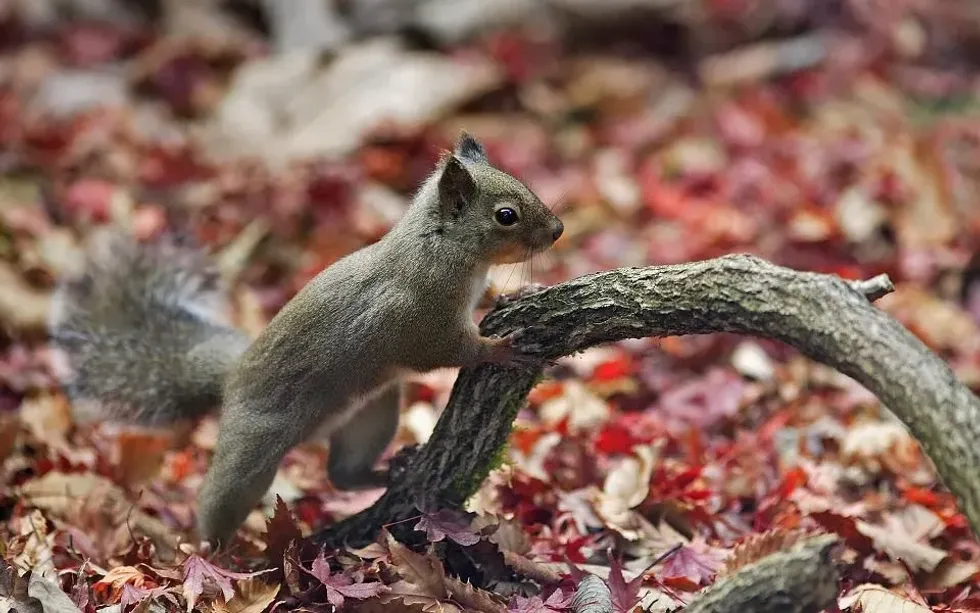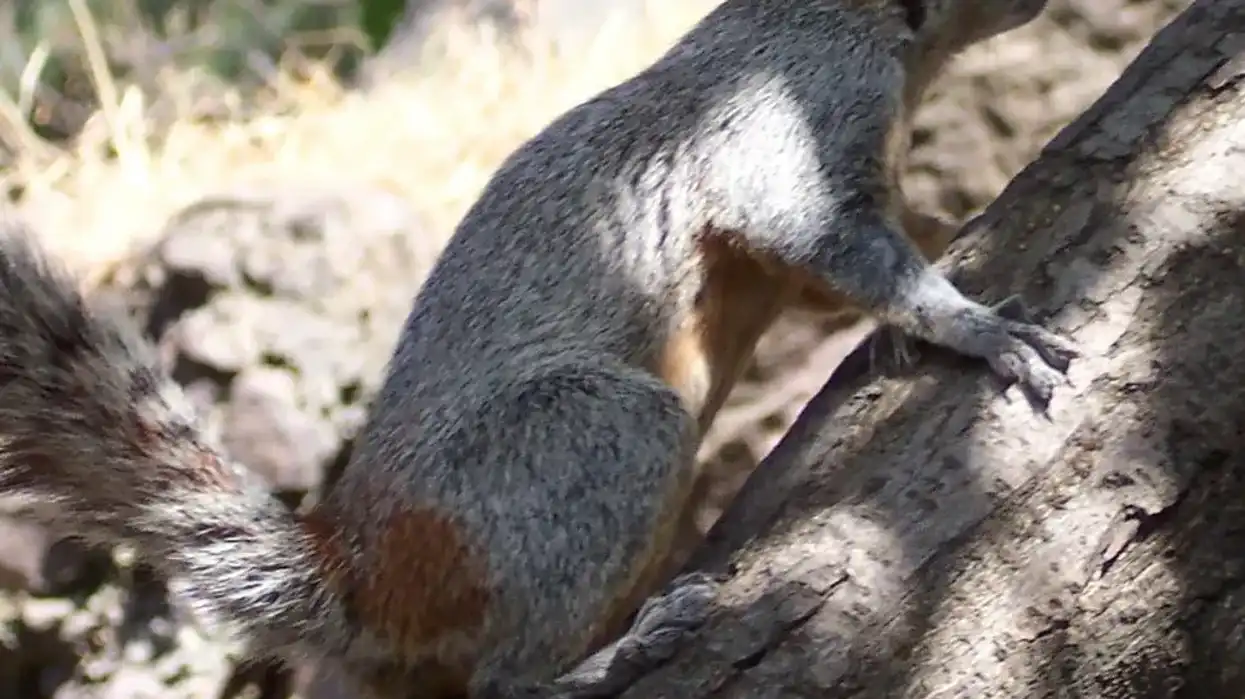The Japanese squirrel (Sciurus lis) is a species of tree squirrel found exclusively in Japan. Adorably cute with large tufted ears and a bushy tail, these squirrels change their fur color according to the season and consume a diet comprised mostly of walnuts.
In summer, their fur is reddish-orange, and in winter, the fur takes on a light brown or grayish look with white parts on the belly and under the chin.
These solitary animals build their nests on forest trees. They have an active life throughout the year and do not hibernate during the winter.
However, like most other squirrel species, these Japanese squirrels are smart enough to plan for the winter ahead and hoard seeds and nuts to survive periods of scarcity. Fortunately, IUCN reports the population trend of this squirrel species to be stable.
If you're curious to know more about the Japanese squirrels, read on! Want to know about more squirrel species? Then check out facts on the antelope squirrel and the red squirrel.
Japanese Squirrel Interesting Facts
What type of animal is a Japanese squirrel?
The Japanese squirrel, Sciurus lis, is a rodent of the squirrel family Sciuridae.
What class of animal does a Japanese squirrel belong to?
Japanese squirrels are rodents that belong to the class Mammalia.
How many Japanese squirrels are there in the world?
No data is available on the total population size of the Japanese squirrels. However, the IUCN reports them as being common throughout most of their natural range.
Where does a Japanese squirrel live?
Japanese squirrels prefer living in the lowlands. They are mostly found in natural forests with mixed species of trees or subalpine areas with pinewoods.
What is a Japanese squirrel's habitat?
The natural range of Japanese squirrels includes the Shikoku, Honshu, and Kyushu Islands of Japan. Recently, forest fragmentation by humans and the resulting habitat loss have caused the population of the Japanese squirrel to dwindle in Shikoku and southwestern Honshu. This squirrel species also recently became extinct in Kyushu.
Who do Japanese squirrels live with?
The Japanese squirrels are primarily solitary animals. However, the adult members may group and nest together during the winter season. Social hierarchy is known to exist among the male and female members, with the older and bulkier members being dominant over the others in the group.
How long does a Japanese squirrel live?
Little is known about the lifespan of a Japanese squirrel.
How do they reproduce?
Female Japanese squirrels are polyestrous with two breeding seasons a year, one from May to June, and the other from February to March. However, the females are receptive to mating only once during each breeding season.
While not much is known about their mating system and reproduction, it is reported that Japanese squirrels have more than one mating partner, with the dominant males securing the most partners.
Like the European red squirrels, the heaviest and dominant females of the Japanese squirrel species are the most fertile. The female's gestation period lasts for about 39-40 days, after which a litter of between two and six young ones is born.
The females raise the young in burrows, den cavities, or leaf nests until they are weaned. The males are not known to be involved in the rearing of the young.
What is their conservation status?
According to the International Union for Conservation of Nature (IUCN) Red List of Threatened Species, Japanese squirrels are classified as of Least Concern.
Japanese Squirrel Fun Facts
What do Japanese squirrels look like?

The males and females of the Japanese squirrel species are almost the same size. Their back is mostly brown, and their front is white.
In addition, the brown fur may have slight streaks of red on the backside along with hints of orange on the shoulders, hips, and lower sides. Their tail is bushy and is usually of the same color as the back part of the body, but maybe white as well.
Their eyes are large and prominent, and so are their tufted ears. A characteristic feature of the Japanese squirrel is that the normally brownish fur on its back and tail assumes a grayish shade during the winter.
How cute are they?
On a cuteness scale of one to 10, with 10 being the cutest, the Japanese squirrels would get a full 10! Their small size, large gleaming eyes, protruding snout, bushy tails, and cartoonish features make them look adorably cute.
How do they communicate?
Very little information is available regarding how the Japanese squirrels communicate. However, studies on their close relatives indicate that Japanese squirrels most likely communicate through scent marks, vocal calls, and specific body postures.
The squirrels use their urine and chin gland secretions to scent mark trunks and branches of trees within their home range. Common sounds emitted by these squirrels may include teeth chattering, moans, and loud chuckles.
Each call is usually associated with a typical body posture. In addition, the mating season may see aggressive behavior such as chasing, tail wagging, foot-stamping, and loud chucks.
How big is a Japanese squirrel?
Japanese squirrels range in length between 6.3-15.3 in (16-39 cm) from the head to the base of the tail with a tail length of around 5.1-6.7 in (13-17 cm). They are almost twice as large as the Japanese dwarf flying squirrel, another squirrel species native to Japan.
How fast can a Japanese squirrel run?
The exact running speed of Japanese squirrels is not available. However, squirrels, in general, are known to have a full running speed of 8-10 mph (13-16 kph).
How much does a Japanese squirrel weigh?
A Japanese squirrel can weigh between 8.8-10.9 oz (250-310 g).
What are the male and female names of the species?
A female squirrel is called a doe, and a male squirrel is called a buck.
What would you call a baby Japanese squirrel?
A baby Japanese squirrel would be called a kit, kitten, or pup.
What do they eat?
These native squirrels of Japan primarily have a herbivorous diet comprising food like fruits, flowers, buds, nuts, seeds, tree leaves, and bark. Japanese walnuts are a predominant food in their diet. Besides eating seeds and nuts, the Japanese squirrels may also feed on insects and fungi.
Are they dangerous?
Squirrels are not known to be particularly aggressive towards humans. However, they may be carriers of infectious diseases, and it is best to keep a distance from them.
Would they make a good pet?
Keeping squirrels as pets is illegal in most places. Despite their apparent friendly nature, they are wild animals, and it is inhuman to try and pet or domesticate them.
Did you know...
Another prominent species of squirrel that are endemic to Japan is the Japanese dwarf flying squirrel. Found in the same geographical range as the Japanese squirrel, the flying squirrels can glide from tree to tree.
An Old World flying squirrel species, the Japanese flying squirrel population is found in the subalpine and boreal evergreen forests of the Shikoku, Honshu, and Kyushu Islands.
If the Japanese squirrels are given a mix of different seeds, their hoarding behavior will make them cache the larger seeds while consuming the smaller ones instantly.
What sounds do flying squirrels make?
Flying squirrels are known to emit chittering noises or short, high-pitched chirps as a form of communication with their kind.
How do you tell if you have flying squirrels?
Flying squirrels are usually smaller than other squirrel species and have flattened tails. Besides, the flying squirrels have a membranous structure stretching between their hind limbs which helps them to glide.
Here at Kidadl, we have carefully created lots of interesting family-friendly animal facts for everyone to discover! Learn more about some other mammals including the Lagotto Romagnolo and the pygmy goat.
You can even occupy yourself at home by drawing one of our Japanese squirrel coloring pages.










